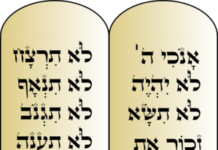Every person has their own perception of reality, their own take on religion, and their own theories on leadership. But every religion as well has their own perception of reality, their own take on religion, and their own theories on leadership. It’s striking to think about how diametrically opposed Jewish leadership is to many other religious versions of leadership. In this week’s parsha, parshas Emor, the Torah tells us that the Kohen Gadol- the high priest- must be married (21:13). Many other religions posit that spiritual leaders must remain celibate, never to marry, as this is the sole path towards spirituality. Why then does Judaism claim the opposite? Is it not true that physicality and physical pleasure can deter one from spiritual perfection? Why do we require our leaders to immerse themselves in such physical matters? In order to understand this, we must first understand the nature and role of kohanim.
Three Categories of Leadership
There are three categories of Jewish leadership: The melech (king), the Sanhedrin (courts), and the kohanim (priests). Each of these categories serve their own unique role. While they all serve both a practical and religious role, each category maintains its own unique purpose in enabling the Jewish people to fulfill their purpose and connect to Hashem. The Melech serves as an embodiment and manifestation of Hashem in this world, negating his ego and serving to reveal Hashem in this world; the Sanhedrin serves to maintain the Jewish ideals in society, ensuring that the Jewish people live up to their purpose. The kohanim serve to help the Jewish people connect to Hashem.
The Kohanim
The role of the kohanim is to guide and lead the Jewish people in their spiritual and religious journey and help them build and perfect their relationship with Hashem. A kohen is thus responsible for our spiritual well-being. The kohanim work in the Beis HaMikdash and help bring korbanos (sacrifices). How does this relate to their role in helping the Jewish people connect to Hashem? In order to understand this, let us briefly review the nature of the Beis HaMikdash.
Beis HaMikdash: Place of Connection
The Beis HaMikdash is referred to by Chazal as the mouth of the world. This is because all the functions of the mouth serve as means of connection. Eating connects the physical body to the angelic soul. Speaking connects people’s inner worlds together. Kissing connects two physical bodies together, reflecting a deeper internal form of connection and oneness. So too, the Beis HaMikdash serves as the “mouth” of the world, as it is where Hashem connects to this physical world.
Speaking
Just as people use their mouths to connect with each other through the mechanism of speech, Hashem spoke directly to the Jewish people specifically in the Beis HaMikdash. The passuk explicitly says that Hashem will speak to Moshe from between the two keruvim- the cherubs (Terumah 25:22). The angels were locked in an embrace of love, reflecting the relationship and connection between Hashem and Klal Yisrael- as husband and wife- true oneness. The Gemara in Yoma 54b also displays how the keruvim’s physical display reflected our relationship with Hashem. When they faced each other, it meant we were close with Hashem; when they turned away from each other, it showed that we had turned away from Hashem.
Kissing
Just as the universal expression of love and connection is through kissing, the Beis HaMikdash is also where Hashem “kisses” the world. The Gemara in Baba Basra 74a states that the Beis HaMikdash is where the heavens kiss the earth. In other words, this is where the infinite and spiritual meet the finite and physical. This is where Hashem most potently connects to the physical world, where Hashem and Klal Yisrael embrace in the most intimate closeness and relationship.
Eating
Just as our physical body needs to eat to maintain its connection to our spiritual soul, the physical world needs to eat in order to maintain its connection to the spiritual soul of the world, Hashem.
We can now understand korbanos (sacrifices) as well. As the Ramban explains, Korbanos come from the word, karov- to bring close. The Nefesh Ha’Chaim (2:9) and the Kuzari (2:26) explain that korbanos are the “food” which feeds the connection between Hashem and the physical world. Just as we eat to connect our soul to our body, korbanos do the same. This explains why many of the details of the avodah, the sacrificial service, has food-like connotations. The mizbeach (the alter) where sacrifices were brought- is referred to as the “shulchan gavo’hah- the high table“, as if this is the table of eating. The passuk consistently refers to the korbanos as “korbani lachmi– My bread sacrifice”, as if the sacrifice is meant to be a meal. This also explains why we place salt on the korbanos, something which halachically we do at meals, especially on Shabbos.
Kohanim: Creating this Connection
The Kohanim serve to foster this connection between both Hashem and this world and Hashem and the Jewish people. In bringing the korbanos, the kohanim serve to connect the physical and spiritual, the Jewish people to their Source.
Kohanim: Spiritual Intermediaries
There is another layer to this as well. As the Maharal explains, seven is the number of the natural, and therefore all physical and natural components of this world are built off sevens: Seven days in the week, seven notes in the musical scale, seven colors in the spectrum of light. Eight represents going beyond the natural, which is why bris milah is done on the eighth day; we take the most physical and potentially animalistic organ and use it to transcend. This is also why the miracle of Chanukah lasted eight days, and is also why it was done with shemen, the same shoresh as shemonah, eight. It is, therefore, no surprise that the gematria- the numerical value- of kohen is 75, the number exactly in between 70 and 80. The kohen’s role is to connect the higher and lower, the physical and spiritual, the infinite and finite. This is done specifically in the Beis HaMikdash, the place of connection.
The Kohen Gadol Must be Married
We can now explain why the Kohen Gadol must be married. The Kohen Gadol embodies the ultimate paradigm of kehunah. He is the ultimate expression of connecting Klal Yisrael to Hashem, connecting the infinite to the finite. As we explained two parshios ago, in order to impact others you must first invest in yourself. This is why Aharon first brought a korban for himself and only afterward brought one for Klal Yisrael. In order to help Klal Yisrael connect with Hashem through a korban of connection, must first ensure that his own personal connection with Hashem is properly established.
So too, before helping Klal Yisrael connect with Hashem- a relationship Chazal refer to as a marriage, Aharon had to first develop his own marriage, his own experience of connection and oneness.
Marriage is the Paradigm of Expanding Your Sense of Self
Marriage is the ultimate opportunity to give yourself fully over to another. This is why the gemara (Kedushin 41a) uses marriage as the paradigm of vi’ahavta li’rei’acha kamocha. Marriage is the first opportunity someone has to completely give themselves over to someone else. Once you love yourself, you can expand your sense of self to include your spouse, your family, your friends, your community, and then all of Klal Yisrael. You can then expand outwards even further to connect with all of humanity, the entire world, and even the entire universe. You can then root yourself back to the source of all self, Hashem Himself. The deepest truth is that while Hashem is the root of all self and existence and is therefore the last step in this process, He is also manifest within everything in this world. So the goal is to be aware of Hashem within every relationship you build: within yourself, your friendships, your marriage, and your connection with all of Klal Yisrael.
The Next Step
Once the Kohen Gadol has experienced the transformative effects of marriage and expanded his sense of self to include all of Klal Yisrael, he is now ready to help Klal Yisrael connect and “marry” Hashem. The Kohen Gadol now understands the meaning of true connection, oneness, and love in his own personal marriage, and simultaneously, in the process of doing so, has built a deeper love and connection with all of Klal Yisrael as well. Now, he is able to help Klal Yisrael connect with Hashem.
Kedoshim Tihiyu
We now come full circle. Last week, we read the words “kedoshim tihiyu”- you shall be holy. This is not a call to be transcendent, angelic beings, lofty and perfect, beyond the struggle innate within the human condition. This is not permission to deny our humanity and restrict our sense of self. This is a calling to be human, to be the ultimate human, to bring transcendence and spirituality into this world. We don’t aim to escape this world, we aim to transform it. Kedushah in not transcendence or escapism, it’s marrying transcendence with the immanent.
The same is true for our spiritual leaders. We don’t seek leaders who transcend human struggle and temptation, sit on mountaintops meditating on their navel. Our leaders are individuals who embrace the physical, uplift it, and connect it to the infinite. Each of us is a leader in our own way, each of us have a unique mission here in this world. May we be inspired to build something powerful, sensational, and transformative within ourselves and then seek to impact the lives of others with our unique talents, helping to build connection and oneness in this world.







